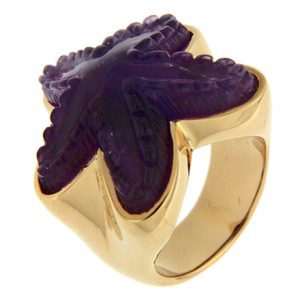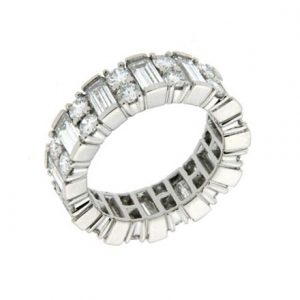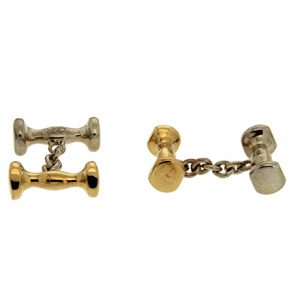Precious metal forms the basis of fine jewelry. It’s malleable enough to shape into wires, wedding bands, beads or any other shape required by the designer. They’re resistant to corroding and oxidization, giving them an element of durability that makes them suited for frequent wear. While precious metal often serves as a means to hold gemstones in jewelry, like in diamond eternity bands, the metals are beautiful in their own right.
It doesn’t take much to turn precious metal into attractive jewelry. They can be polished in a number of ways, from a matte brush finish made of many thin parallel lines, to a mirror bright shine. Metals can be embossed, engraved, decorated with tiny beads or left plain. Precious metals may also be alloyed with other materials for durability and to make a prettier finished product.
Gold
Gold Jewelry

Gold is typically measured in karats, describing the ratio of the metal to the components it’s alloyed with. The purest form of gold is 24kt. Though it is resistant to heat, moisture, air and most corrosive agents, gold is weak and will easily scratch. To add strength, allowing the metal to last as a piece of jewelry, it is usually blended with varying quantities of other materials such as silver, copper or nickel. Altering the proportions combinations of gold and its alloys will produce a range of colors known as white, yellow, rose and green gold
For centuries, wedding rings were traditionally made of gold to ensure that the jewelry would last, holding its appearance over time while being suitable for everyday wear. To care for your gold jewelry it is best to use a gold cleaning liquid or warm soapy water with a non-abrasive cloth. Remember to remove all gold jewelry before entering swimming pools since chlorine will erode the metal, making it possible to loosen stones from their settings. It is just as important to keep gold away from chemicals like household cleaners, which can create abrasions in the metal and reduce its shine.
Platinum
Platinum Jewelry

Platinum is a distinctive metal with superior durability and a bright white luster that helps to reflect the brilliance of diamonds. Jewelry that is 95.5% platinum will be resistant to fading and tarnishing, keeping its appearance for life. Platinum’s purity makes it hypoallergenic and ideal for those with metal allergies and skin sensitivity. Its density and weight make it more durable and sturdier than other jewelry metals, holding precious stones securely in place.
Similar to all precious metals, platinum will scratch; however, it can be polished and restored easily with little weight loss. Platinum is the perfect choice for frequently worn jewelry, such as engagement and wedding rings. It is the strongest of metals used in jewelry and requires the least amount of maintenance. To care for your platinum jewelry you can use either a jewelry cleaning solution or soak it in warm, soapy water and gently dry with a lint-free cloth. You should not handle bleach or other harsh substances when wearing platinum jewelry. Even though they won’t harm the platinum, chemicals may discolor diamonds or gemstones. Over time, platinum pieces will develop a natural patina giving jewelry a duller finish. When this happens, you can take your piece to a qualified jeweler to have it polished back to its original state or you may decide you prefer this look to the other.
Platinum was used by the ancient Egyptians in their jewelry and to decorate the tombs of pharaohs. During this period it was alloyed with gold, though it’s hard to tell if it was accidental or deliberate. The La Tolita culture of Columbia and Ecuador took advantage of local platinum deposits to create rings, earrings, masks and other fanciful objects. Due to platinum’s melting point of 1772C, or 3221.6F, it was many centuries before other societies developed the technology to work with this precious metal.
It wasn’t until 1758 that scientists rediscovered how to melt platinum. By the 1780s, King Louis XVI of France declared it to be the only metal fit for kings, and commissioned precious objects made from platinum. The metal received a massive boost of popularity during the Edwardian era and the period’s love of lacy diamond jewelry. The shine of platinum highlighted the brilliance of diamonds, and was strong enough to take on delicate designs without warping.
In its pure form, platinum is too soft for use in jewelry. To give it enough hardness to help it maintain its shape, it’s alloyed with other metals. The resulting blend is usually between 85-95% platinum. When mixed with cobalt in a 95:5 ratio, platinum takes on a consistency that lends itself well to casting. Platinum mixed with iridium is suitable for stamping, welding and other tasks. A specific platinum-ruthenium blend is strong enough for use in watches, and is also favored for diamond wedding bands.
Platinum is a popular choice for precious metal jewelry for many reasons. For people with sensitive skin, its hypoallergenic properties make it comfortable to wear. It’s a lightweight metal, making it an ideal choice for those who enjoy wearing large pieces for long amounts of time. Platinum is also resistant to tarnishing, helping one’s jewelry remain bright for a long time to come.
Titanium
Titanium is a 99% pure metal that is lightweight, strong, and lustrous. This substance is hard, wears well, and withstands corrosion from outside sources, including seawater and chlorine. One can wear titanium jewelry while swimming with few worries.
Titanium is notably stronger than steel but with only 60% its density, making it ideal for jewelry. Due to the metal’s characteristics of strength and resistance to temperature, titanium is used in jewelry as well as in aircrafts, spacecrafts, naval ships and missiles. Titanium displays a unique and fashionable texture that will not cause any metallic allergies. It can be polished to a high sheen, and is just as attractive when matte. Like other jewelry metals, titanium can best be cleaned with warm, soapy water and a soft cloth to restore its natural finish.
Tungsten Carbide
The name “Tungsten” is derived from the Swedish words “Tung,” meaning heavy and “Sten,” meaning stone. Tungsten is a grayish-white lustrous metal with a high density, strong properties and the highest melting point of any metal. When it is mixed with carbon, the resulting compound, tungsten carbide, is so hard it needs to be polished with diamonds. It is probably the toughest metal used in jewelry manufacturing at present time. The most common form of tungsten carbide in jewelry is cemented carbide, which creates an exceptionally durable substance.
Tungsten carbide is a great metal for jewelry use as it will retain its polish longer than other metals and is able to resist damage and corrosion by most minerals and toxins in the atmosphere. It can be buffed to a mirror-like finish using diamonds. Unlike most metals, it will retain its perfect finish for decades. Jewelry made from tungsten carbide will never need re-polishing and is virtually resistant to scratching. Its exceptional endurance makes it the perfect metal for men’s jewelry items. Similar to stainless steel and titanium, it is hypoallergenic as well as environmentally friendly. Tungsten carbide jewelry requires very little care and maintenance. Simply rubbing it with a clean cloth will restore its gleam. Tungsten carbide jewelry will truly last a lifetime with no sign of wear or tear.
Stainless Steel
Stainless steel is an alloy of iron and carbon, with chromium added to help resist oxidation. This material also has a greater ability to withstand rust and corrosion in many natural and man-made environments as opposed to most other metals. It has a protective oxide layer that is too thin to effect appearance but makes the metal impervious to water and air. If the surface is scratched, this shield quickly reforms.
Stainless steel has quickly become one of the newer fashion trends in the market. Jewelry grade stainless steel, also known as valadium, is often alloyed with nickel. It is ideal for use in jewelry because it will not bend or break, change color or tarnish, and is hypoallergenic for those with metal allergies. Though it isn’t optimal for setting stones, it can be inlaid with other materials such as gold or tungsten. To care for your stainless steel jewelry it is best to soak it in soapy water or detergent before wiping dry with a soft cloth. Window cleaner is another option to remove grease and heavy grime. Do not use harsh abrasives which may damage its natural protective coat.
Silver

Silver is one of the most lustrous metals found on Earth. Its ease of shaping makes it a valuable material with which to create fine jewelry. Jewelry grade silver is usually 92.5% pure, alloyed with copper for added strength and durability. Silver has a metallic, grey-white hue in its polished state, but other finishes such as matte have become increasingly popular. Today, silver is even crafted with colored gemstones and diamonds for a simple elegance, appropriate for day or evening attire.
Silver has been used for thousands of years, with evidence of mines in Asia Minor dating to the 4th millennium B.C.E. It has been used for currency, to create precious objects such as mirrors, cups and teapots, and to make jewelry. While silver may tarnish, or discolor, it’s resistant to corrosion and is highly malleable, allowing artists to be free with their imaginations.
To make silver durable, it’s usually alloyed with other materials. Sterling silver is 92.5% silver and 7.5% copper. This alloy has been used since at least the early Middle Ages, with sterling silver coins issued at the time of William the Conqueror. Britannia silver, introduced by an act of Parliament in 1697, is 95.83% silver and 4.17% copper. It’s softer than sterling silver, and not commonly used for jewelry today. Argentium sterling silver was patented in 1998, and contains 93.5% silver as well as copper and germanium.
Silver jewelry has been popular in many times and places, including ancient Egypt, Minoa, Phoenicia and the Roman empire. Advances in diamond cutting around the 17th century helped turn diamonds from a dark gemstone into a jewel capable of brilliance. The whitish grey hue of silver complemented the shine and sparkle of colorless diamonds, starting a trend that lasted for centuries.
Today, silver is sought out by the budget conscious who enjoy the beauty of white metal. Designers still make use of the metal’s ductility, creating delicate forms or elaborate pieces filled with details. It’s also fashionable to give silver touches of color, be it through enamel, gemstones, or combining silver with gold.
Over time, silver will slowly tarnish when exposed to environmental elements, such as chlorine and hairspray. To protect and whiten silver jewelry, the pieces are usually plated with rhodium, a form of platinum that will help to maintain silver’s luster and appearance with wear. Not all silver jewelry is plated, however, and understanding the difference is important for the care of your jewelry.
Rhodium plated silver is generally cleaned with a soft polishing cloth and soapy water or a fine cleaner. Applying abrasives to plated silver may remove portions of the finish. If your silver is not plated you may want to store your pieces in a tarnish prevention cloth or bag. The treated cloth slows the tarnishing process and keeps the jewelry free from scratches. Silver without plating can be cleaned with a phosphate free detergent, a low abrasive cleaner or silver polish to remove tarnish.
Please Contact Us should you have any questions.





